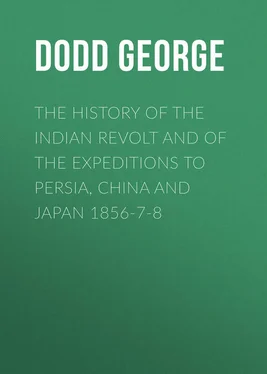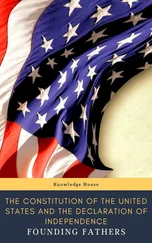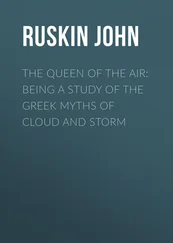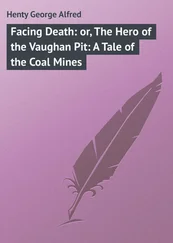George Dodd - The History of the Indian Revolt and of the Expeditions to Persia, China and Japan 1856-7-8
Здесь есть возможность читать онлайн «George Dodd - The History of the Indian Revolt and of the Expeditions to Persia, China and Japan 1856-7-8» — ознакомительный отрывок электронной книги совершенно бесплатно, а после прочтения отрывка купить полную версию. В некоторых случаях можно слушать аудио, скачать через торрент в формате fb2 и присутствует краткое содержание. Жанр: foreign_antique, foreign_prose, на английском языке. Описание произведения, (предисловие) а так же отзывы посетителей доступны на портале библиотеки ЛибКат.
- Название:The History of the Indian Revolt and of the Expeditions to Persia, China and Japan 1856-7-8
- Автор:
- Жанр:
- Год:неизвестен
- ISBN:нет данных
- Рейтинг книги:3 / 5. Голосов: 1
-
Избранное:Добавить в избранное
- Отзывы:
-
Ваша оценка:
- 60
- 1
- 2
- 3
- 4
- 5
The History of the Indian Revolt and of the Expeditions to Persia, China and Japan 1856-7-8: краткое содержание, описание и аннотация
Предлагаем к чтению аннотацию, описание, краткое содержание или предисловие (зависит от того, что написал сам автор книги «The History of the Indian Revolt and of the Expeditions to Persia, China and Japan 1856-7-8»). Если вы не нашли необходимую информацию о книге — напишите в комментариях, мы постараемся отыскать её.
The History of the Indian Revolt and of the Expeditions to Persia, China and Japan 1856-7-8 — читать онлайн ознакомительный отрывок
Ниже представлен текст книги, разбитый по страницам. Система сохранения места последней прочитанной страницы, позволяет с удобством читать онлайн бесплатно книгу «The History of the Indian Revolt and of the Expeditions to Persia, China and Japan 1856-7-8», без необходимости каждый раз заново искать на чём Вы остановились. Поставьте закладку, и сможете в любой момент перейти на страницу, на которой закончили чтение.
Интервал:
Закладка:
It is necessary, as a matter of historical truth, to describe briefly the condition of the house of slaughter on the 17th of July; and this cannot be better done than in the words employed by the officers and soldiers in various letters written by them, afterwards made public. The first that we shall select runs thus: ‘I have seen the fearful slaughter-house; and I also saw one of the 1st native infantry men, according to order, wash up part of the blood which stains the floor, before being hanged.’ [This order will presently be noticed in the words of Brigadier Neill.] ‘There were quantities of dresses, clogged thickly with blood; children’s frocks, frills, and ladies’ underclothing of all kinds; boys’ trousers; leaves of Bibles, and of one book in particular, which seems to be strewed over the whole place, called Preparation for Death ; broken daguerreotypes; hair, some nearly a yard long; bonnets, all bloody; and one or two shoes. I picked up a bit of paper with the words on it, “Ned’s hair, with love;” and opened and found a little bit tied up with ribbon. The first [troops] that went in, I believe, saw the bodies with their arms and legs sticking out through the ground. They had all been thrown in a heap in the well.’ A second letter: ‘The house was alongside the Cawnpore hotel, where the Nena lived. I never was more horrified. I am not exaggerating when I tell you that the soles of my boots were more than covered with the blood of these poor wretched creatures. Portions of their dresses, collars, children’s socks, and ladies’ round hats, lay about, saturated with their blood; and in the sword-cuts on the wooden pillars of the room, long dark hair was sticking, carried by the edge of the weapon, and there hung their tresses – a most painful sight. I picked up a mutilated Prayer-book; it appeared to have been open at page 36 of the Litany, where I have little doubt those poor creatures sought and found consolation in that beautiful supplication; it is there sprinkled with blood.’ A third: ‘We found that the Nena had murdered all the women and children that he had taken prisoners, and thrown them naked down a well. The women and children had been kept in a sort of zenana, and no attention whatever paid to cleanliness. In that place they had been butchered, as the ground was covered with clotted blood. One poor woman had evidently been working, as a small work-box was open, and the things scattered about. There were several children’s small round hats, evidently shewing that that was their prison. The well close by was one of the most awful sights imaginable.’ A fourth: ‘It is an actual and literal fact, that the floor of the inner room was several inches deep in blood all over; it came over men’s shoes as they stepped. Tresses of women’s hair, children’s shoes, and articles of female wear, broad hats and bonnets, books, and such like things, lay scattered all about the rooms. There were the marks of bullets and sword-cuts on the walls – not high up, as if men had fought – but low down, and about the corners where the poor crouching creatures had been cut to pieces. The bodies of the victims had been thrown indiscriminately into a well – a mangled heap, with arms and legs protruding.’ Some of the officers, by carefully examining the walls, found scraps of writing in pencil, or scratched in the plaster, such as, ‘Think of us’ – ‘Avenge us’ – ‘Your wives and families are here in misery and at the disposal of savages’ – ‘Oh, oh! my child, my child.’ One letter told of a row of women’s shoes, with bleeding amputated feet in them , ranged in cruel mockery on one side of a room; while the other side exhibited a row of children’s shoes, filled in a similarly terrible way; but it is not certain whether the place referred to was Cawnpore. Another writer mentioned an incident which, unless supported by collateral testimony, seems wanting in probability. It was to the effect that when the 78th Highlanders entered Cawnpore, they found the remains of Sir Hugh Wheeler’s daughter. They removed the hair carefully from the head; sent some of it to the relations of the unfortunate lady; divided the rest amongst themselves; counted every single hair in each parcel; and swore to take a terrible revenge by putting to death as many mutineers as there were hairs. The storm of indignant feeling that might suggest such a vow can be understood easily enough; but the alleged mode of manifestation savours somewhat of the melodramatic and improbable.
A slight allusion has been made above to Brigadier Neill’s proceedings at Cawnpore, after the fatal 17th of July. In what relation he stood to the reconquering force will be noticed in its due place; but it may be well here to quote a passage from a private letter, written independently of his public dispatches: ‘I am collecting all the property of the deceased, and trying to trace if any have survived; but as yet have not succeeded in finding one.’ [Captain Bruce’s research, presently to be mentioned, had not then been made.] ‘Man, woman, and child, seem all to have been murdered. As soon as that monster Nena Sahib heard of the success of our troops, and of their having forced the bridge about twenty miles from Cawnpore, he ordered the wholesale butchery of the poor women and children. I find the officers’ servants behaved shamefully, and were in the plot, all but the lowest-caste ones. They deserted their masters and plundered them. Whenever a rebel is caught, he is immediately tried, and unless he can prove a defence, he is sentenced to be hanged at once; but the chief rebels or ringleaders I make first clean up a certain portion of the pool of blood, still two inches deep, in the shed where the fearful murder and mutilation of women and children took place. To touch blood is most abhorrent to the high-caste natives; they think by doing so they doom their souls to perdition. Let them think so. My object is to inflict a fearful punishment for a revolting, cowardly, barbarous deed, and to strike terror into these rebels… The well of mutilated bodies – alas! containing upwards of two hundred women and children – I have had decently covered in and built up as one grave.’
With one additional testimony, we will close this scene of gloomy horror. The Earl of Shaftesbury, as was noticed in a former page, took occasion soon after the news of the Cawnpore atrocities reached London, to advert at a public meeting to the shrinking abhorrence with which those deeds were regarded, and to the failure of the journalists to present the full and fearful truth. He himself mentioned an incident, not as an example of the worst that had been done by the incarnate fiends at Cawnpore, but to indicate how much remains to be told if pen dare write or tongue utter it: ‘I have seen a copy of a letter written and sent to England by an officer of rank who was one of the first that entered Cawnpore a few hours after the perpetration of the frightful massacre… To his unutterable dismay, he saw a number of European women stripped stark naked, lying on their backs, fastened by the arms and legs; and there many of them had been lying four or five days exposed to a burning sun; others had been more recently laid down; others again had been actually hacked to pieces, and so recently, that the blood which streamed from their mangled bodies was still warm. He found children of ten, twelve, thirteen, and fourteen years of age treated in the same horrible manner at the corners of the streets and in all parts of the town: attended by every circumstance of insult, the most awful and the most degrading, the most horrible and frightful to the conception, and the most revolting to the dignity and feelings of civilised men. Cawnpore was only a sample of what was perpetrated in various parts of that vast region, and that with a refinement of cruelty never before heard of. Women and children have been massacred before; but I don’t believe there is any instance on record where children have been reserved in cold blood to be most cruelly and anatomically tortured in the presence of their horrified parents before being finally put to death.’
Читать дальшеИнтервал:
Закладка:
Похожие книги на «The History of the Indian Revolt and of the Expeditions to Persia, China and Japan 1856-7-8»
Представляем Вашему вниманию похожие книги на «The History of the Indian Revolt and of the Expeditions to Persia, China and Japan 1856-7-8» списком для выбора. Мы отобрали схожую по названию и смыслу литературу в надежде предоставить читателям больше вариантов отыскать новые, интересные, ещё непрочитанные произведения.
Обсуждение, отзывы о книге «The History of the Indian Revolt and of the Expeditions to Persia, China and Japan 1856-7-8» и просто собственные мнения читателей. Оставьте ваши комментарии, напишите, что Вы думаете о произведении, его смысле или главных героях. Укажите что конкретно понравилось, а что нет, и почему Вы так считаете.












